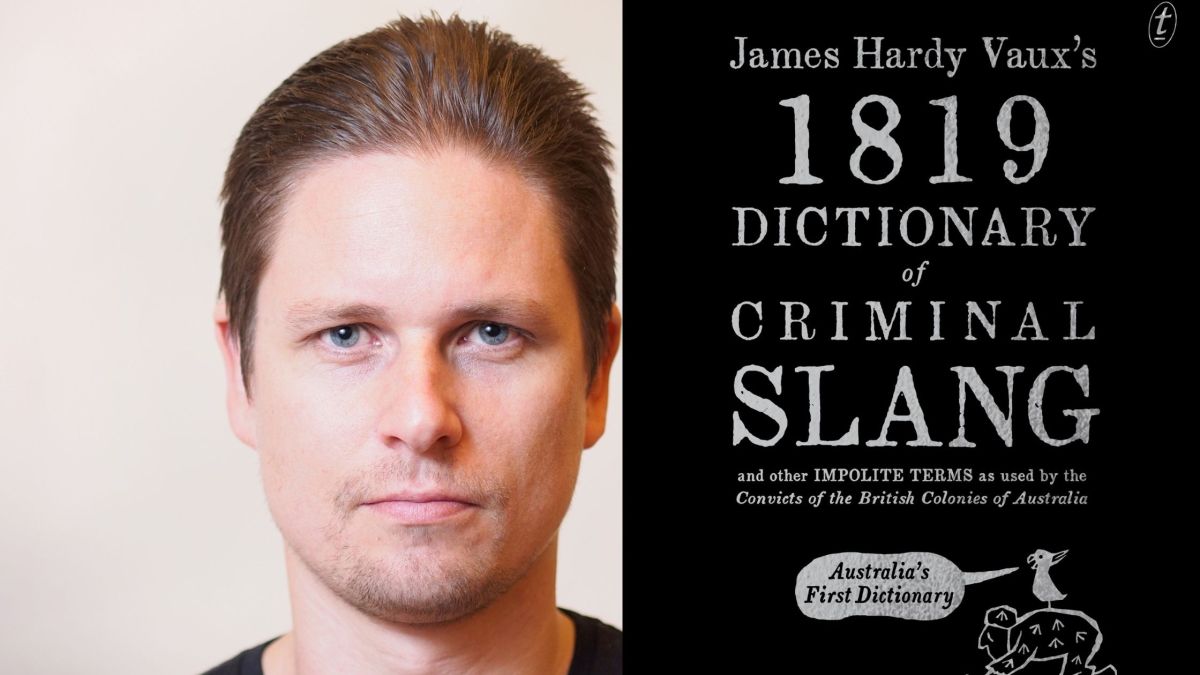A dictionary is a snapshot of a time, a place and a culture. Former convict (transported three times including a conviction for forgery) James Hardy Vaux captured the spoken cant of his fellow thieves in the colony of New South Wales mostly for the benefit of judges who couldn’t understand the language used by the accused.
Some words are from Cockney rhyming slang including the use of beef (for stop thief) while others are from Romany, French or other European languages. Stolen words are designed to disguise and soften nefarious deeds in the colony – just as they were used in Cockney rhyming slang.
The modern reader needs a guide to this language. Enter writer and illustrator Simon Barnard who frames Hardy Vaux’s original text with anecdotes and context. The original text has been published before (and can be read as part of the Guttenberg Project) but what Barnard creates is context based on research to find stories behind the words. The result is a lively look at a language that is often humorous though sometimes dark.
The word “rump’d”, for example is defined by Hardy Vaux as ‘flogged or scourged’. Barnard gives us three examples of convicts being “rump’d” including horrible whippings that left their collarbones looking like ‘two ivory Polished horns’. While a doctor attended these floggings, Barnard’s accompanying cartoon for the word shows a convict shattered to pieces.
Then there are words that are time capsules like “barking irons” for guns because to colonists’ ears the sound of a shot was like a dog barking. Another sign of the times was the practice of “snuffing”, which occurred when going into a shop to throw snuff into a shopkeeper’s face then grabbing what you could. It sounds like an obscure kind of crime, but it happened regularly enough that it got its very own word. Barnard digs up the example of a Joseph Behrens who was busted for snuffing to swipe earrings, only to be transported for seven years when he was caught. A sentence not to be sneezed at.
Read: Book review: Storytellers by Leigh Sales
Unsurprisingly for a book about understanding criminals there are a lot of words for theft or violence – including the cartoonish “milling” where an attacker comes at you rolling their arms over like a windmill. The word “fib”, which once meant “to box”, gives other phrases like “fibbing match” (for a boxing match) and the curious “fibbing-gloak” (for a boxer). Unlike “fib”, which has come to mean a lie, some words have stuck closer to their original meaning such as “seedy” and “snitch”, which Hardy Vaux notes here.
What is missing are words from First Nations peoples. By the time Australia’s first dictionary (as the cover proudly claims) was published, the European colony had been established for over 30 years, but no language from our First Peoples appears as part of this slang guide. As a look at a language, this book makes for an entertaining and dippable read ideal for lovers of the vernacular. As a historical document about Australia, however, it is also about what is not said and who is unseen.
James Hardy Vaux’s 1819 Dictionary of Criminal Slang, James Hardy Vaux and Simon Barnard
Publisher: Text Publishing
ISBN: 9781923058033
Format: Paperback
Pages: 320pp
Price: $29.99
Publication: 31 October 2023





